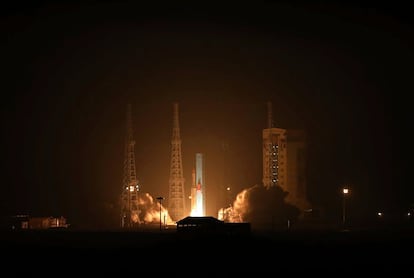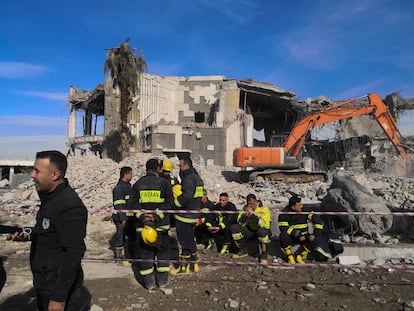Iran launches 3 satellites into space that are part of a Western-criticized program as tensions rise
The launch comes as heightened tensions grip the wider Middle East over Israel’s continued war on Hamas in the Gaza Strip, sparking fears of a regional conflict

Iran said Sunday it successfully launched three satellites into space with a rocket that had multiple failures in the past, the latest for a program that the West says improves Tehran’s ballistic missiles.
The launch comes as heightened tensions grip the wider Middle East over Israel’s continued war on Hamas in the Gaza Strip, sparking fears of a regional conflict.
While Iran has not intervened militarily in the conflict, it has faced increased pressure within its theocracy for action after a deadly Islamic State suicide bombing earlier this month and as proxy groups like Yemen’s Houthi rebels conduct attacks linked to the war. Meanwhile, Western nations remain worried about Iran’s rapidly expanding nuclear program.
Footage released by Iranian state television showed a nighttime launch for the Simorgh rocket. An Associated Press analysis of the footage showed that it took place at the Imam Khomeini Spaceport in Iran’s rural Semnan province.
“The roar of the Simorgh (rocket) resonated in our country’s sky and infinite space,” said Abbas Rasooli, a state TV reporter, in the footage.
State TV named the launched satellites Mahda, Kayhan-2 and Hatef-1. It described the Mahda as a research satellite, while the Kayhan and the Hatef were nanosatellites focused on global positioning and communication respectively. Iran’s Information and Communications Technology Minister Isa Zarepour said the Mahda had already sent signals back to Earth.
There have been five failed launches in a row for the Simorgh program, a satellite-carrying rocket. The Simorgh, or “Phoenix,” rocket failures have been part of a series of setbacks in recent years for Iran’s civilian space program, including fatal fires and a launchpad rocket explosion that drew the attention of former U.S. President Donald Trump.
The footage showed the rocket launched Sunday bore the slogan “We Can” in Farsi, likely referring to the previous failures.
The Simorgh is a two-stage, liquid-fueled rocket the Iranians described as being designed to place satellites into a low Earth orbit.
However, the U.S. intelligence community’s 2023 worldwide threat assessment said the development of satellite launch vehicles “shortens the timeline” for Iran to develop an intercontinental ballistic missile because it uses similar technology. That report specifically cites the Simorgh as a possible dual-use rocket.
The United States has previously said Iran’s satellite launches defy a U.N. Security Council resolution and called on Tehran to undertake no activity involving ballistic missiles capable of delivering nuclear weapons. U.N. sanctions related to Iran’s ballistic missile program expired last October.
Under Iran’s relatively moderate former President Hassan Rouhani, the Islamic Republic slowed its space program for fear of raising tensions with the West. However, in the time since, the 2015 nuclear deal Rouhani shepherded with world powers has collapsed and tensions have been boiling for years with the U.S.
Hard-line President Ebrahim Raisi, a protégé of Supreme Leader Ayatollah Ali Khamenei who came to power in 2021, has pushed the program forward. Meanwhile, Iran enriches uranium closer than ever to weapons-grade levels and enough material for several atomic bombs, though U.S. intelligence agencies and others assess Tehran has not begun actively seeking a nuclear weapon.
On Friday, France, Germany and the United Kingdom condemned an Iranian satellite launch on Jan. 20, similarly calling it capable of helping Iran develop long-range ballistic missiles.
“We have longstanding concerns over Iran’s activity related to ballistic missile technologies that are capable of delivering nuclear weapons,” the countries said. “These concerns are reinforced by Iran’s continued nuclear escalation beyond all credible civilian justification.”
Tehran maintains the largest arsenal of ballistic missiles in the Mideast, in part due to decades of sanctions following its 1979 Islamic Revolution and the U.S. Embassy hostage crisis blocking it from advanced fighter jets and other weapon systems.
The U.S. military and the State Department did not immediately respond to requests for comment Sunday. However, the U.S. military has quietly acknowledged the Jan. 20 launch conducted by the country’s paramilitary Revolutionary Guard was successful.
Sign up for our weekly newsletter to get more English-language news coverage from EL PAÍS USA Edition
Tu suscripción se está usando en otro dispositivo
¿Quieres añadir otro usuario a tu suscripción?
Si continúas leyendo en este dispositivo, no se podrá leer en el otro.
FlechaTu suscripción se está usando en otro dispositivo y solo puedes acceder a EL PAÍS desde un dispositivo a la vez.
Si quieres compartir tu cuenta, cambia tu suscripción a la modalidad Premium, así podrás añadir otro usuario. Cada uno accederá con su propia cuenta de email, lo que os permitirá personalizar vuestra experiencia en EL PAÍS.
¿Tienes una suscripción de empresa? Accede aquí para contratar más cuentas.
En el caso de no saber quién está usando tu cuenta, te recomendamos cambiar tu contraseña aquí.
Si decides continuar compartiendo tu cuenta, este mensaje se mostrará en tu dispositivo y en el de la otra persona que está usando tu cuenta de forma indefinida, afectando a tu experiencia de lectura. Puedes consultar aquí los términos y condiciones de la suscripción digital.
More information
Archived In
Últimas noticias
‘Sleepless City’: The light of cinema illuminates Madrid’s Cañada Real shantytown
All the effects of gentrification in one corner of Mexico’s Colonia Roma
Palestinian reporter Youmna El Sayed: ‘My family told me I had to choose between being a journalist or a mother’
The new language of the workplace: Knowing how to ask AI questions is more important than using it
Most viewed
- Families demand repatriation of bodies of Colombians who died in Ukraine: ‘This war is a slaughterhouse for foreigners’
- The low-cost creative revolution: How technology is making art accessible to everyone
- Liset Menéndez de la Prida, neuroscientist: ‘It’s not normal to constantly seek pleasure; it’s important to be bored, to be calm’
- Christian Louboutin: ‘Young people don’t want to be like their parents. And if their parents wear sneakers, they’re going to look for something else’
- ‘El Limones’ and the growing union disguise of Mexican organized crime










































